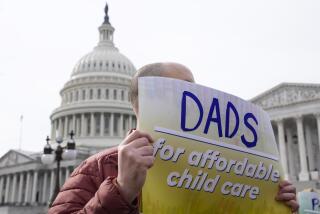With Tax Code Aid, Firms Ease Child-Care Cost
- Share via
I couldn’t believe it when I read last year that we could get up to $11,500 of our income in tax-free dollars to pay for child-care,” says a UCLA professor. “It was buried in an administration notice of benefits changes, and I seemed to be the only person on campus who even read it. I almost missed it myself.”
“It” is a new tax benefit that is relatively unknown and only occasionally available, and although 1986 tax reform limited the amount to $5,000, it’s expected to become the most common corporate assistance to working parents. Under the Economic Recovery Tax Act of 1981, “dependent care assistance” that an employer offers as one option under a “flexible” benefits plan is deductible for an employer and not taxable for the employee. Companies were thus encouraged to help with child-care expenses as they help with medical costs, either with direct subsidy or a salary-reduction program like the University of California’s.
The environment that prodded this concern about child-care is hardly unknown--with almost 55% of women working, half of all mothers with infants under 1 year old, and more than two-thirds of working women with preschool children working full time. Single or married, they work out of necessity and need child care in order to work, but the only government recognition of the drain on their finances was a 10-year-old federal income tax credit which assumed a maximum expenditure of only $2,400 a year for one-income households and $4,800 for two-income.
Use It or Lose It
These provisions of the 1981 tax law were hailed as a great incentive. Companies already involved in funding local day care centers and referral services--Procter & Gamble, for example--soon added dependent care subsidies to their benefits menus. More are expected to favor the salary-reduction plans, or “reimbursement accounts,” which help employees without requiring outright contribution from employers.
Such plans require that specific amounts be deducted, before tax, from the eligible employee’s salary and deposited in an account from which the employee draws by filing “claims.” The employee--or employee and spouse, if married--must work, and must register the name of the individual or facility providing the care. Furthermore, any funds deposited but not used in a given year are forfeited.
“It’s a use-it-or-lose it amount,” says Warren Clark, vice president for group employee benefit sales at Pacific Mutual Life Insurance, which is starting to include the option in flexible benefits plans it sets up for client companies.
A further consideration is that the same money can’t be counted twice for tax advantage--that is, expenses paid with such untaxed funds can’t be claimed for the child-care tax credit. If they spend more than the maximum allowed in either case, employees can use both the tax credit and the untaxed dollars, but which should take precedence depends on their income.
Income Makes Difference
Lower income earners generally do better with the tax credit, because the lower the income, the higher the percentage of child-care expenses credited: 30% on incomes under $10,000 compared to 20% on incomes over $28,000. Higher income workers, in higher tax brackets, do better with salary reduction: a 28% tax bracket means a saving of $280 on every $1,000 of pretax dollars while a bracket of 10% saves only $100.
Employers will favor salary-reduction plans simply because they don’t cost companies too much. There is no actual subsidy involved, administrative costs of the program are minimal, and the company actually saves money, says Clark, because it does not have to pay payroll taxes--predominantly Social Security--on the funds.
By 1986, only an estimated 2,000 employers nationwide offered any kind of child-care assistance, according to the House Committee on Children, Youth and Families. Of 2,000 companies offering flexible benefits in 1986, 75% included a child-care option, most often a salary-reduction plan, says Dana Friedman, senior research associate for the Conference Board in New York.
On rather limited experience, there is already some indication that child-care benefits will be popular. Among eligible Procter & Gamble employees, dependent care benefits in general--subsidy or salary reduction--are among the most popular options. Among companies Friedman studied, utilization of salary-reduction plans “could be as high as 25% of eligible employees.”
Nevertheless, the new plans have been criticized for their inequity, given the greater advantage to employees in the highest tax brackets.
“Government has always responded to middle-class needs,” says Ronald Soloway, executive director of the Center for Public Advocacy Research in New York, “and here government permits upper-income people to be subsidized, people who corporations are most desirous of keeping at work.”
Burden Shifted
To Friedman, such plans are “a foot in the door, a way for companies to become sensitive to the whole question of child care.” But Soloway thinks that the attractiveness of such plans to employers may also keep them from offering other, perhaps more generous help to working parents. Salary reduction, he says, actually shifts the burden of meeting employees’ child-care needs from employers “back to government and individual workers--despite the benefits accruing to business from a work force more productive because of stable child-care arrangements.”
Even employees who gladly take advantage of such plans may be ambivalent. The dependent care plan, says the UCLA professor, seems indicative of a “schizophrenic” society and an unsure Congress: “Why be so uncooperative in the normal situation--the child-care credit available to everyone is a joke--and in a special situation, for selected employees, suddenly so generous?
“And why set up a system where you have to project expenditures ahead? Why not just let everyone deduct a more reasonable percentage of actual expenses, like 50%? After all, people can still deduct 80% of their business lunches, which just doesn’t seem as important as child care.”
More to Read
Inside the business of entertainment
The Wide Shot brings you news, analysis and insights on everything from streaming wars to production — and what it all means for the future.
You may occasionally receive promotional content from the Los Angeles Times.










